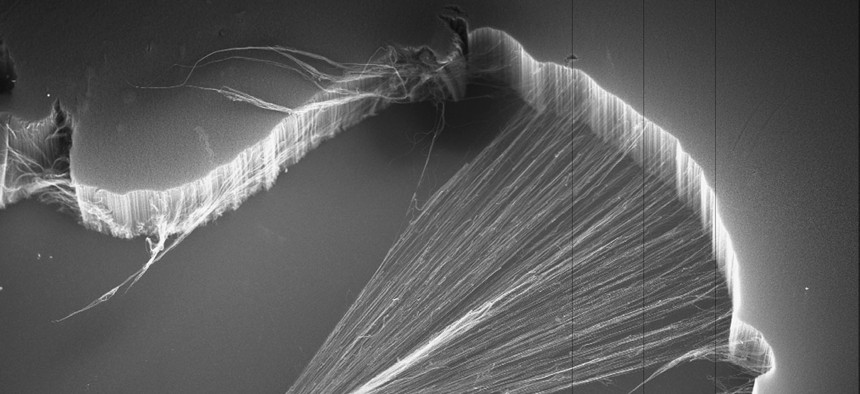The Military Is Genetically Modifying Bacteria to Make Even Tinier Computers
The biosynthetic microbe could wire future nanoelectronics after Navy-funded researchers supercharged its conductivity.
A microbe so common it’s found everywhere from the muddy bottom of the Potomac River to soil hundreds of meters into the earth could one day be wiring the military’s nanotechnology and sensing toxic chemicals from unmanned vehicles.
The bacteria, called Geobacter, thrive where organic life normally couldn’t in an “unprecedented” way, said Derek Lovley, a microbiology professor at the University of Massachusetts Amherst working with the U.S. Navy.
Here’s how it works. Rather than expelling electrons through oxygen-based respiration, Geobacter grow hair-like protein filaments that transfer electrons out of the cell onto surrounding iron minerals. Over the past year, Lovley and a team of researchers genetically modified those protein filaments to supercharge their conductivity, as part of an ongoing collaboration with the Office of Naval Research. The researchers tweaked two of the protein’s amino acids, halving their size and increasing their conductivity 2,000-fold, ONR officials announced Tuesday:
"Research like Dr. Lovley's could lead to the development of new electronic materials to meet the increasing demand for smaller, more powerful computing devices," said Linda Chrisey, a program officer in ONR's Warfighter Performance Department, which sponsors the research. "Being able to produce extremely thin wires with sustainable materials has enormous potential application as components of electronic devices such as sensors, transistors and capacitors."
The filaments conduct electricity the same way copper does, making them promising alternatives for wiring in the military’s future nanoelectronics. Although this first test comes nowhere near copper’s conductivity, the modified Geobacter pili already are as effective as man-made alternatives like carbon nanotubes, Lovley said. Better yet, they have none of the issues associated with manufacturing large quantities of the carbon nanotubes, which has proved difficult to scale up due to resource constraints and laborious purification processes.
“We usually grow [Geobacter] on acetate, or acetic acid, which is basically what’s in vinegar—those kind of cheap and renewable resources,” he said. “And it’s very stable for a protein … so for example, they’re stable in boiling water. Stable at a very basic or very high pH. For a protein for they’re remarkably robust and stable.”
The bacteria could pair with other synthetic biological innovations the military is pursuing, including transmitting electricity to other bioengineered microbes producing butanol as an alternative fuel for the military’s remote outposts.
Beyond wiring and transistor applications, Lovley said he envisions a future with “the wire itself being a sensor.” If there’s a chemical the military wants to detect without exposing troops to—say, one found in explosives or toxic pollutants—researchers could further modify Geobacter so the nanowire itself binds with that chemical whenever the two come into contact, Lovley said. The altered bacteria could then be added to a silicon chip on an unmanned vehicle.
Though Lovley and his team discovered Geobacter’s conductive nanowires a decade ago, it was only last year that they started brainstorming in earnest with colleagues in polymer science about modifying the bacteria’s properties.
“The idea that there was a microbe that would make a wire to conduct electricity out of the cell was pretty revolutionary, and there was a lot of controversy,” he said. “So we really spent like nine of those 10 years studying the biological role.”
ONR’s Rear Adm. Mat Winter said the Navy has been sponsoring the Geobacter research for many years among the three-to-four thousand grants it awards to academic partners annually.
“It’s important to keep that volume focused” on basic research, said Winter,, at the Center for Strategic and International Studies last month. That creates “solution space so that ideas that can be knitted together for capabilities to emerge.”
In Geobacter’s case, this has paid off. Before genetically engineering the microbe’s filaments, Lovley’s team had already discovered its ability to serve as microbial fuel cells. The Navy is exploring applications of that now, including sustainably powering sensors embedded on the ocean floor.
“We continue to focus on advanced materials in our laboratories and understanding how we can do microbial energy, where we’re taking the positive electrons that are made on the microbes on the seabed, and we’re capturing those, and we’re hooking up some red and black connectors, and we’re gathering the electricity,” Winter said at CSIS. “So we’re not there yet, but … machines at the nano-level are going to be an incredible game-changer.”




